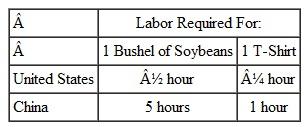
Microeconomics 6th Edition by Robert Hall, Shirley Kuiper, Marc Lieberman
النسخة 6الرقم المعياري الدولي: 978-1133708735
Microeconomics 6th Edition by Robert Hall, Shirley Kuiper, Marc Lieberman
النسخة 6الرقم المعياري الدولي: 978-1133708735 تمرين 8
More Challenging
Go back to Table 1 in the chapter,which is based on the hours requirements in Table 2. Suppose that when trade opens up between the U.S. and China,the U.S. increases its production of soybeans by 100 bushels (instead of 10 as in the table). China increases its production of T-shirts by 400 (instead of 40). Assume that when the two countries trade with each other,each bushel of soybeans is exchanged for 3 T-shirts. Finally,suppose that the U.S. trades (exports)90 bushels of soybeans to China.
Table 1 A Beneficial Change in World Production
 Table 2 Labor Requirements for Soybeans and T-Shirts
Table 2 Labor Requirements for Soybeans and T-Shirts
 a. How many T-shirts from China will the U.S. receive in exchange for its soybean exports to China?
a. How many T-shirts from China will the U.S. receive in exchange for its soybean exports to China?
b. After trading with China,how many more bushels of soybeans will be available for Americans to consume (compared to the situation before trade)? How many more T-shirts?
c. After trading with the U.S.,how many more bushels of soybeans will be available for the Chinese to consume? How many more T-shirts?
d. Based on this example,consider the following statement: "When two countries trade with each other,one country's gain will always be the other country's loss." Is this statement true or false? Explain briefly.
Go back to Table 1 in the chapter,which is based on the hours requirements in Table 2. Suppose that when trade opens up between the U.S. and China,the U.S. increases its production of soybeans by 100 bushels (instead of 10 as in the table). China increases its production of T-shirts by 400 (instead of 40). Assume that when the two countries trade with each other,each bushel of soybeans is exchanged for 3 T-shirts. Finally,suppose that the U.S. trades (exports)90 bushels of soybeans to China.
Table 1 A Beneficial Change in World Production
 Table 2 Labor Requirements for Soybeans and T-Shirts
Table 2 Labor Requirements for Soybeans and T-Shirts  a. How many T-shirts from China will the U.S. receive in exchange for its soybean exports to China?
a. How many T-shirts from China will the U.S. receive in exchange for its soybean exports to China?b. After trading with China,how many more bushels of soybeans will be available for Americans to consume (compared to the situation before trade)? How many more T-shirts?
c. After trading with the U.S.,how many more bushels of soybeans will be available for the Chinese to consume? How many more T-shirts?
d. Based on this example,consider the following statement: "When two countries trade with each other,one country's gain will always be the other country's loss." Is this statement true or false? Explain briefly.
التوضيح
(a)The terms of trade between United Sta...
Microeconomics 6th Edition by Robert Hall, Shirley Kuiper, Marc Lieberman
لماذا لم يعجبك هذا التمرين؟
أخرى 8 أحرف كحد أدنى و 255 حرفاً كحد أقصى
حرف 255








